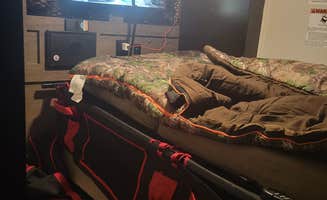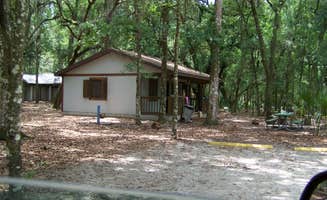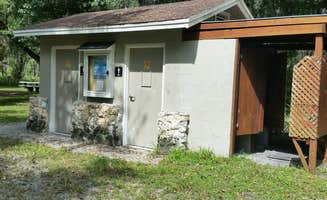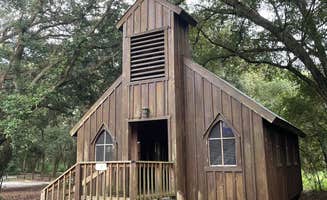Fort De Soto Campground and Terry Tomalin Campground provide premier glamping options near Pinellas Park, Florida, located in a subtropical climate zone with average summer temperatures reaching 90°F. Camping opportunities in this region range from primitive tent sites with minimal amenities to luxury cabins with modern facilities. Sites typically require booking 3-6 months in advance during peak winter season when temperatures range from 52-72°F.
What to do
Paddling adventures: Hillsborough River State Park offers kayak rentals where visitors can explore the river's unique ecosystem. "Great bike trails, good cell coverage with wifi at the office. Electric and water. 2 dump sites on property," notes David G. about Fort De Soto Campground.
Wildlife viewing: Watch for varied wildlife across multiple preservation areas. "This place was newly renovated for guest to stay. The campsites are nicely spaced out so you aren't too close to other campers. The trails are amazing but be careful or you might get lost," writes Caleb H. about Terry Tomalin Campground.
Hiking trails: Explore the extensive trail networks throughout the region. "We spent the day hiking the numerous off-road trails and enjoying some of the amenities the park has to offer. The park has separate primitive tent, car-camping (tent) and cabin campgrounds near the entrance of the park along with over 50 miles of biking, hiking, nature as well as equestrian trails to enjoy," reports Steve S. about Jay B. Starkey Wilderness Park.
What campers like
Waterfront access: Many sites offer direct water access for fishing and water activities. "Nearly every campsite is right on the water - easy in and out for kayaks, large boat ramp and many picnic pavilions. Great trails for bike riding and wonderful for saltwater fishing among the mangroves," mentions Jeanene A. about E.G. Simmons Regional Park.
Natural surroundings: The region's parks maintain natural buffers between sites. "You drive about a mile down the road from the main state park entrance to find the wilderness preserve entrance which is code protected. After driving back to the parking area, we realized we had the 600 acres to ourselves," shares Christina L. about her experience at Palmetto Ridge Campground.
Dark skies: Minimal light pollution creates excellent stargazing opportunities. "Nice place, relatively quiet. Little light pollution. Sites are very spacious. Close and clean facilities. Saw a good bit of wildlife: deer and wild boar," notes AJ G. about the camping experience at Starkey Wilderness Preserve.
What you should know
Insect preparation: No-see-ums and mosquitoes can be problematic, especially at dusk. "They could have carried us away but nothing you can do about that! Nice size lots on most sites," advises Amanda about E.G. Simmons Regional Park. "The bugs can be bad this time they were bad last year no problem. We had a screened room that has a no see um mesh on it and we blast a big fan in there so we do stay semi bug free," suggests B M.
Reservation requirements: Many parks require advance booking through separate reservation systems. "Reservations can be made for camping up to 90 days in advance either online or at the park," explains Steve S. about Jay B. Starkey Wilderness Park. "Only reason for the 4 start is the reservation system has to be done through the county park and rec sites," mentions AJ G.
Site variations: Campsite quality varies significantly within the same park. "The sites are VERY spacious (could easily fit 5 large tents here) and the back of the site has a trail that leads directly to The McNeil Homestead. If you're looking for a bit of a spook, I highly suggest walking this at night time," recommends Shaun C. about Cypress Creek Preserve.
Tips for camping with families
Playground access: Several parks feature accessible playgrounds. "There is a playground with good swings and also a sturdy playground that offered plenty of opportunity for my four year old to blow off some steam. The ground is all recycled rubber, which I love as a parent," reports Joe R. about Fort De Soto Park.
Educational opportunities: Nature centers provide learning experiences for children. "Nature education center for children. Playgrounds and pavilions for get togethers. Large group bon fire pits and cabins for rent," mentions Tim L. about Jay B. Starkey Wilderness Park.
Water safety awareness: Be vigilant around water areas with children. "Went to drain the tanks yesterday morning and a large sounding gator started to growl territorially at me. So heads up with your pets please," warns jenelle J. at Palmetto Ridge Campground.
Tips from RVers
Site selection strategy: Choose sites based on specific needs and seasons. "The Big Flats & Old Prairie loops are gravel road, tight, no privacy & very small sites like for popups, vans or small campers. The Palmetto Ridge pull thrus are gigantic," explains Amanda W. about camping at Palmetto Ridge Campground.
Utility limitations: Check what hookups are available before booking. "We stayed at site 55 of the East CG which was right on the water where we launched our kayaks to paddle the canals amongst the Mangroves. Great place to paddle a kayak in the Mangrove canals. Right on Tampa Bay," shares Bran P. about E.G. Simmons Regional Park.
Local services: Note the distance to nearest supplies and services. "If by chance you have forgotten anything, avoid paying double or triple the price at the on-site market by going to either Walmart or Publix, which are both about a mile and half away," advises Stuart K. about glamping options near Pinellas Park.






